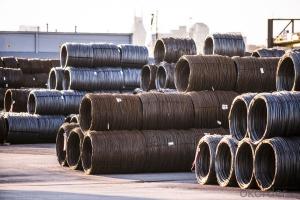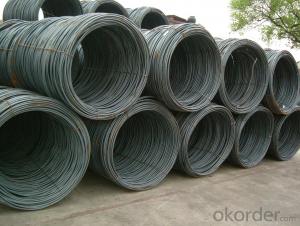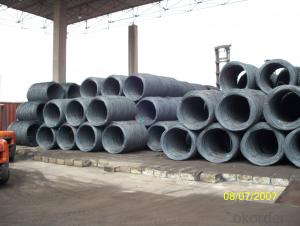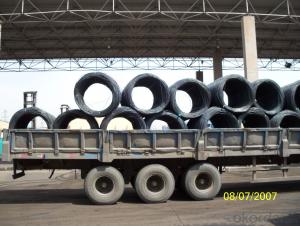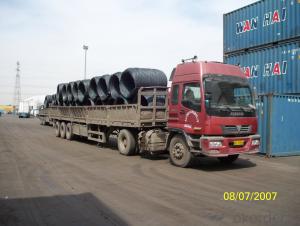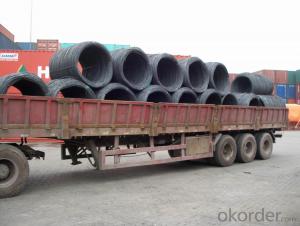SAE1006Cr Carbon Steel Wire Rod 6.5mm for Welding
- Loading Port:
- Shanghai
- Payment Terms:
- TT OR LC
- Min Order Qty:
- 100 m.t
- Supply Capability:
- 30000 m.t/month
OKorder Service Pledge
OKorder Financial Service
You Might Also Like
Item specifice
Description of SAE1006Cr Carbon Steel Wire Rod 6.5mm for Welding:
OKorder is offering Color Coated Steel Coil Prepainted Steel Coil at great prices with worldwide shipping. Our supplier is a world-class manufacturer of steel, with our products utilized the world over. OKorder annually supplies products to European, North American and Asian markets. We provide quotations within 24 hours of receiving an inquiry and guarantee competitive prices.
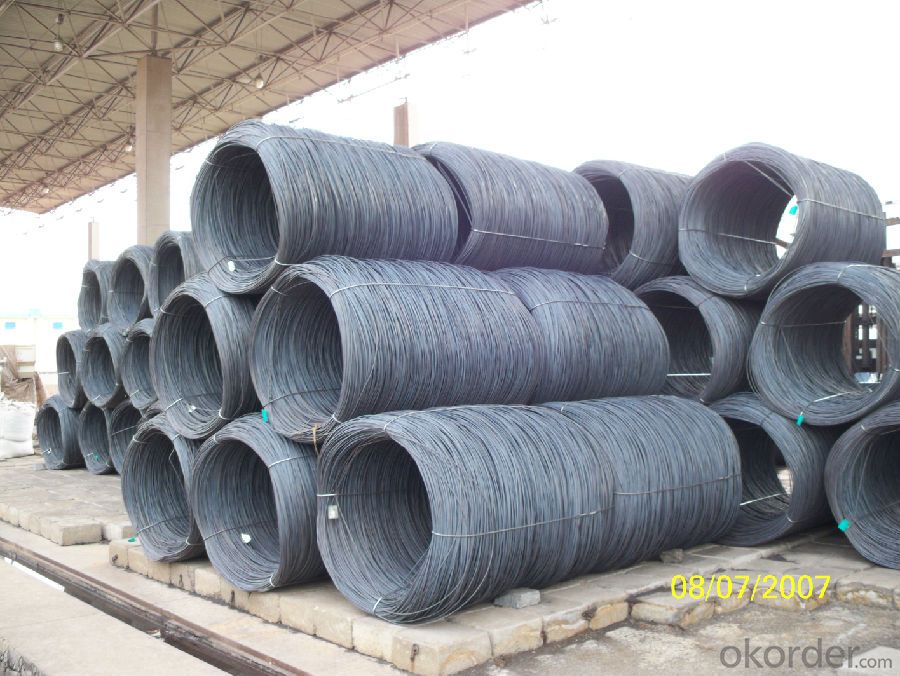
Applications of SAE1006Cr Carbon Steel Wire Rod 6.5mm for Welding:
Color Coated Steel Coil Prepainted Steel Coil are ideal for structural applications and are widely used in the construction of buildings and bridges, and the manufacturing, petrochemical, and transportation industries.
Main Product Features of SAE1006Cr Carbon Steel Wire Rod 6.5mm for Welding:
· Premium quality
· Prompt delivery & seaworthy packing (30 days after receiving deposit)
· Corrosion resistance
· Can be recycled and reused
· Mill test certification
· Professional Service
· Competitive pricing
Specifications of SAE1006Cr Carbon Steel Wire Rod 6.5mm for Welding:
PPGI:
1, Introduction: Color coated steel coils(sheets), i. E. PPGI, also called prepainted steel coils(sheets), are made of galvanized steel coils(sheets) with polymer coatings as surface. It's a new enclosure material and building board with characteristics of light-weighted, heat preserved&insulated, easily installed with bright colors.
2, Production Process: Pretreatment(Degreasing)_Drying_Chromating_Paint Basic Oil_Cooling_Drying_Color Coating_Cooling_Film-covering_Rolling Up
3, Characteristics:
Good at corrosion resistence. Besides zinc coating of the basic plate of galvanized steel sheet, the color coating as the surface has double lifetime to ensure better anticorrosion effect.
With excellent cold bending molded manufacturablity, PPGI products can be processed or directly used as final product. As being light-weighted and conveniently transported, they're widly used to replace wood to save energy.
There're thousands of colors can be chosen as per different application. Any color plays well in decoration.
No pollution with high recycling rate, PPGI coils and sheets are strongly recommended as enviroment-friendly products by the government.
5, eye bands and 4 circumferential bands in steel, galvanized metal fluted rings on inner and outer edges, galvanized.
| commodity | SAE1006Cr Carbon Steel Wire Rod 6.5mm for Welding |
| Techinical Standard: | JIS G3302-1998, EN10142/10137, ASTM A755 |
| grade | Q195,Q215,Q235,SAE1006,SAE1008 SAE1006Cr |
| Types: | Mesh welding |
| Base metal | galvanized, galvalume, cold rolled steel |
| Thickness | 0.14-1.0mm(0.16-0.8mm is the most advantage thickness) |
| Width | 610/724/820/914/1000/1200/1219/1220/1250mm |
| Type of coating: | PE, SMP, PVDF |
| Zinc coating | Z60-150g/m2 or AZ40-100g/m2 |
| Top painting: | 5 mic. Primer + 15 mc. R. M. P. |
| Back painting: | 5-7 mic. EP |
| Color: | According to RAL standard |
| ID coil | 508mm610mm |
| Coil weight: | 2--3MT |
| Package: | Properly packed for ocean freight exportation in 20'containers |
| Application: | Industrial panels, roofing and siding for painting/automobile |
| Price terms | FOB, CFR, CIF |
| Payment terms | 20%TT in advance+80% TT or irrevocable 80%L/C at sight |
| delivery time | 25 days after recepit of 20% TT |
| Remarks | Insurance is all risks |
| MTC 3.1 will be handed on with shipping documents | |
| We accept SGS certificatation test |
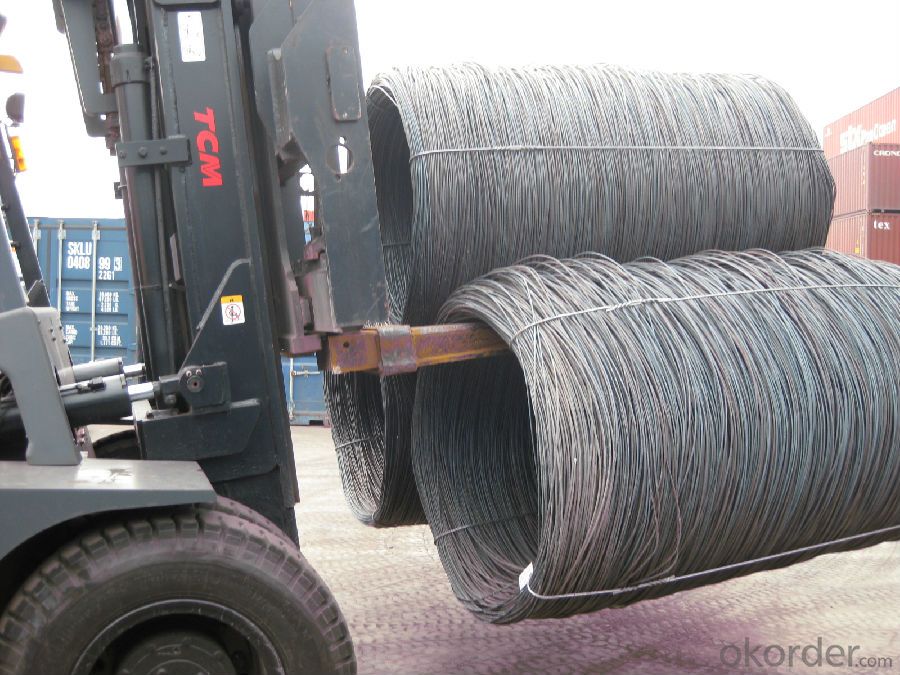
FAQ of SAE1006Cr Carbon Steel Wire Rod 6.5mm for Welding:
Q1: Why buy Materials & Equipment from OKorder.com?
A1: All products offered byOKorder.com are carefully selected from China's most reliable manufacturing enterprises. Through its ISO certifications, OKorder.com adheres to the highest standards and a commitment to supply chain safety and customer satisfaction.
Q2: How do we guarantee the quality of our products?
A2: We have established an advanced quality management system which conducts strict quality tests at every step, from raw materials to the final product. At the same time, we provide extensive follow-up service assurances as required.
Q3: How soon can we receive the product after purchase?
A3: Within three days of placing an order, we will begin production. The specific shipping date is dependent upon international and government factors, but is typically 7 to 10 workdays.
Q4: What makes stainless steel stainless?
A4: Stainless steel must contain at least 10.5 % chromium. It is this element that reacts with the oxygen in the air to form a complex chrome-oxide surface layer that is invisible but strong enough to prevent further oxygen from "staining" (rusting) the surface. Higher levels of chromium and the addition of other alloying elements such as nickel and molybdenum enhance this surface layer and improve the corrosion resistance of the stainless material.
Q5: Can stainless steel rust?
A5: Stainless does not "rust" as you think of regular steel rusting with a red oxide on the surface that flakes off. If you see red rust it is probably due to some iron particles that have contaminated the surface of the stainless steel and it is these iron particles that are rusting. Look at the source of the rusting and see if you can remove it from the surface.
- Q:What are the common applications of low carbon steel wire rod?
- Low carbon steel wire rod has a wide range of applications due to its various beneficial properties. Some of the common applications of low carbon steel wire rod include: 1. Construction: Low carbon steel wire rod is widely used in the construction industry for various purposes. It is commonly used for reinforcing concrete structures such as beams, columns, and slabs. The high tensile strength and ductility of low carbon steel wire rod make it an ideal choice for reinforcing purposes. 2. Manufacturing: Low carbon steel wire rod is extensively used in manufacturing industries for the production of various products. It is commonly used for manufacturing nails, screws, bolts, and other fasteners due to its excellent formability and strength. Additionally, it is used in the production of wire mesh, wire ropes, and cables. 3. Automotive industry: Low carbon steel wire rod finds applications in the automotive industry as well. It is used for manufacturing parts such as springs, suspension systems, and tire cords. The flexibility, strength, and durability of low carbon steel wire rod make it suitable for these applications. 4. Agriculture: In the agricultural sector, low carbon steel wire rod is commonly used for constructing fences and wire mesh. It provides durability and strength to the fencing systems, ensuring the security of livestock and crops. Additionally, it is used for making trellises and support structures for plants. 5. Household applications: Low carbon steel wire rod is also used in various household applications. It is used for making hangers, racks, and shelves due to its ability to withstand heavy loads. Additionally, it is used for manufacturing kitchen utensils, wire baskets, and other household items. Overall, low carbon steel wire rod is a versatile material used in numerous industries and applications. Its properties such as formability, strength, and durability make it a preferred choice for various manufacturing and construction purposes.
- Q:What is the typical chemical composition of steel wire rod?
- The typical chemical composition of steel wire rod can vary depending on the specific grade and intended use of the wire rod. However, the most common chemical composition of steel wire rod includes iron as the main element, along with small amounts of carbon, manganese, phosphorus, sulfur, and silicon. Carbon is an important element in steel wire rod as it provides strength and hardness to the material. Manganese is often added to improve the hardenability and strength of the steel. Phosphorus and sulfur are impurities that are typically minimized as they can negatively affect the properties of the steel. Silicon is added to enhance the steel's deoxidation and improve its resistance to corrosion. It is important to note that different grades of steel wire rod may have varying amounts of these elements, as well as the inclusion of other alloying elements such as chromium, nickel, or molybdenum, which are added to achieve specific properties and characteristics required for different applications.
- Q:What are the main distribution channels for steel wire rod?
- The main distribution channels for steel wire rod include direct sales to manufacturers, wholesalers, and distributors.
- Q:What are the common production processes for alloy steel wire rod?
- The common production processes for alloy steel wire rod include melting and refining the raw materials, continuous casting to form a solid billet, hot rolling the billet into wire rod, followed by cooling, surface treatment, and final inspection and packaging.
- Q:What are the different types of steel wire rod surface defects?
- There are several types of steel wire rod surface defects, including scale, pitting, cracks, scratches, and rust.
- Q:How is steel wire rod used in the manufacturing of wire forms for elevator cables?
- Steel wire rod is a crucial component in the manufacturing of wire forms for elevator cables. The steel wire rod is first processed and drawn into a specific diameter and shape to meet the required strength and flexibility needed for elevator cables. The wire rod is then heated and coated with a protective layer to enhance its durability and resistance against corrosion. Once the steel wire rod is prepared, it is further processed to form wire strands. These wire strands are then twisted together to create elevator cables with the desired strength and load-bearing capacity. The number of wire strands and the tightness of the twisting are determined by the specific requirements of the elevator cable. The use of steel wire rod in the manufacturing of wire forms for elevator cables ensures the cables can withstand the heavy loads and continuous movement involved in elevator operation. The strength and flexibility of the steel wire rod contribute to the overall safety and reliability of the elevator cables. Additionally, the steel wire rod used in elevator cable manufacturing undergoes strict quality control measures to meet industry standards and regulations. This ensures that the wire forms produced using steel wire rod are of high quality, capable of withstanding the rigorous demands of elevator systems. In conclusion, steel wire rod plays a vital role in the manufacturing of wire forms for elevator cables. Its strength, flexibility, and durability are essential for creating elevator cables that can safely and reliably transport passengers and goods within buildings.
- Q:How does the thermal conductivity of steel wire rod vary with different heat treatment processes?
- The thermal conductivity of steel wire rod can vary with different heat treatment processes. Heat treatment processes such as annealing or quenching can affect the microstructure of the steel, leading to changes in its thermal conductivity. Annealing, for example, can result in a more uniform and refined grain structure, increasing the thermal conductivity of the steel wire rod. On the other hand, quenching, which involves rapid cooling, can lead to a harder and more brittle microstructure, potentially decreasing the thermal conductivity. Therefore, the specific heat treatment process employed can have a significant impact on the thermal conductivity of steel wire rod.
- Q:What are the common applications of pre-stressed and oil tempered steel wire rod?
- Pre-stressed steel wire rod is commonly used in construction and engineering applications, such as for pre-tensioning or post-tensioning of concrete structures, bridges, and high-rise buildings. It helps to improve the load-bearing capacity, durability, and overall structural integrity of these projects. On the other hand, oil tempered steel wire rod is frequently utilized in the manufacturing of springs, suspension systems, and other high-stress applications. Its unique properties, obtained through the tempering process, provide excellent resistance to fatigue and ensure reliable performance in demanding industries such as automotive, aerospace, and machinery.
- Q:What are the common types of steel used for wire rod production?
- Wire rod production utilizes a variety of steel types, including carbon steel, alloy steel, and stainless steel. Carbon steel stands as the most prevalent option, owing to its affordability and versatility. Comprised mainly of iron and carbon, it also contains trace amounts of other elements. In contrast, alloy steel merges iron with additional elements like manganese, chromium, or nickel. This type of steel boasts heightened strength, durability, and resistance to wear and tear. Conversely, stainless steel finds common use in wire rod production, particularly when corrosion resistance is imperative. With a high chromium content, it forms a protective oxide layer on the surface, preventing rust and corrosion. These diverse steel types present varying properties and characteristics, enabling manufacturers to meet specific requirements for wire rod production across different industries.
- Q:What are the common applications of low alloy steel wire rod?
- Low alloy steel wire rod is commonly used in various applications such as construction, automotive, aerospace, and manufacturing industries. It is often used for the production of high-strength fasteners, springs, cables, welding electrodes, and other components that require excellent strength, durability, and resistance to wear and corrosion.
1. Manufacturer Overview |
|
|---|---|
| Location | |
| Year Established | |
| Annual Output Value | |
| Main Markets | |
| Company Certifications | |
2. Manufacturer Certificates |
|
|---|---|
| a) Certification Name | |
| Range | |
| Reference | |
| Validity Period | |
3. Manufacturer Capability |
|
|---|---|
| a)Trade Capacity | |
| Nearest Port | |
| Export Percentage | |
| No.of Employees in Trade Department | |
| Language Spoken: | |
| b)Factory Information | |
| Factory Size: | |
| No. of Production Lines | |
| Contract Manufacturing | |
| Product Price Range | |
Send your message to us
SAE1006Cr Carbon Steel Wire Rod 6.5mm for Welding
- Loading Port:
- Shanghai
- Payment Terms:
- TT OR LC
- Min Order Qty:
- 100 m.t
- Supply Capability:
- 30000 m.t/month
OKorder Service Pledge
OKorder Financial Service
Similar products
New products
Hot products
Related keywords
